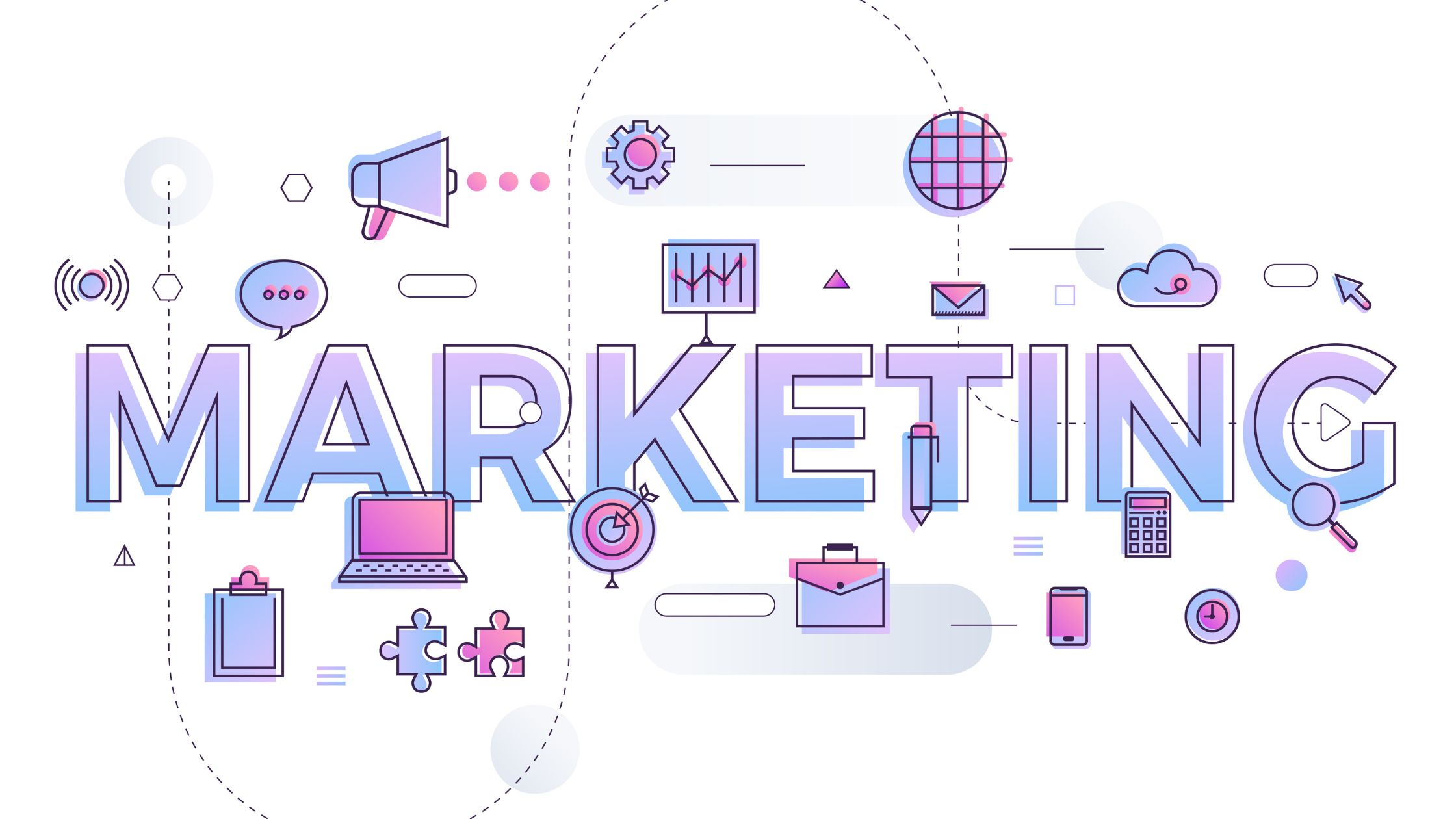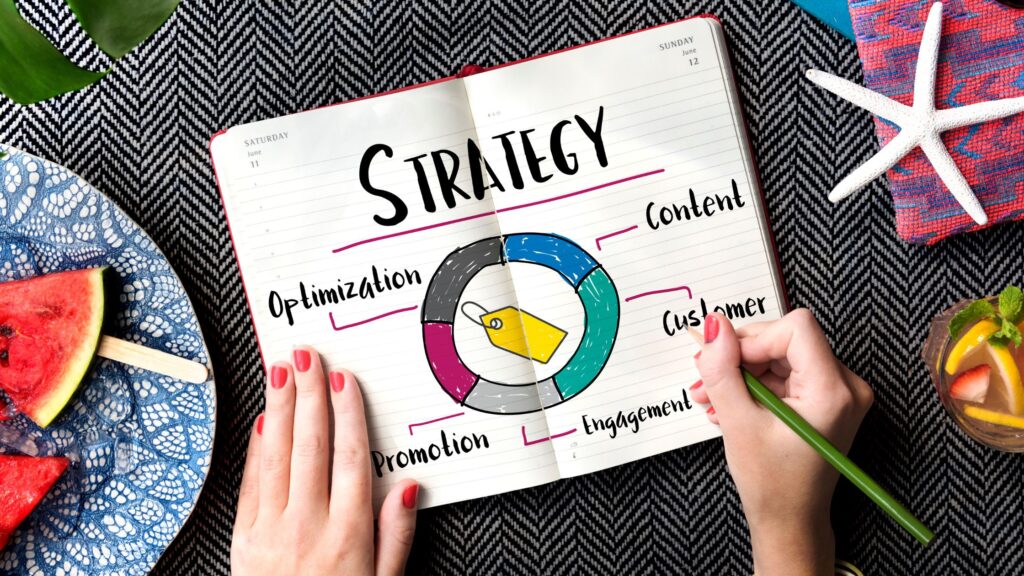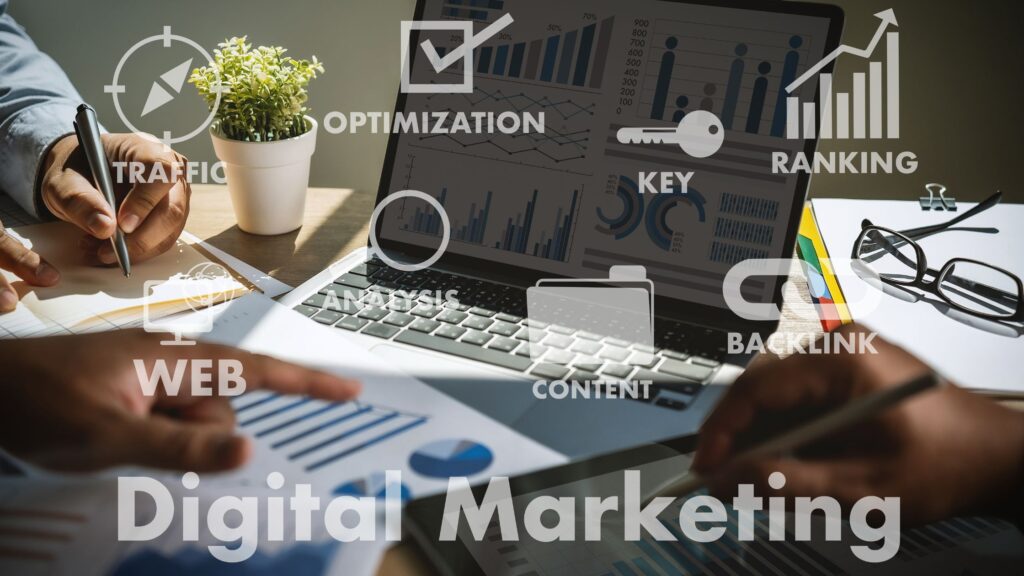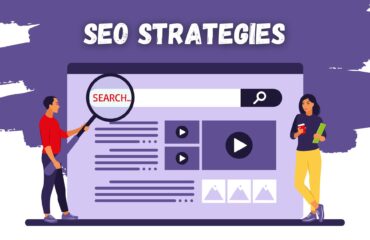
Insight into How Digital Marketing Integrates with Traditional Marketing Efforts to Create a Comprehensive Marketing Strategy.
In an era where the digital and traditional realms of marketing are increasingly interwoven, understanding the synergy between the two becomes crucial for crafting a marketing strategy that is not only comprehensive but also profoundly impactful. As we navigate through this convergence, it’s essential to understand not just the individual strengths of each approach, but more importantly, how integrating digital and traditional marketing strategies can create a powerful, cohesive plan for success. This integration is not just a trend but a comprehensive method to ensure your brand resonates with your audience across every platform and touchpoint.
At AlgoRythm Solutions, we stand at the forefront of this innovative approach, crafting marketing strategies that seamlessly blend the reach and familiarity of traditional methods with the precision and engagement of digital tactics. Our expertise lies in not only understanding the distinct dynamics of each marketing form but in leveraging their combined strengths to forge a unified, impactful message that captivates and converts.
The digital marketing landscape, with its array of tools like SEO, social media, and content marketing, offers unprecedented opportunities to connect with audiences in real-time, providing personalized experiences that traditional channels alone cannot match. However, dismissing traditional marketing in favour of digital is a mistake many make. Traditional methods, with their broad reach and tangible presence, continue to hold significant value, offering a sense of credibility and permanence that digital channels are still building towards.
In this comprehensive guide, we delve into the essence of integrating digital and traditional marketing, offering insights into creating a strategy that not only reaches but resonates with your target audience, driving growth and establishing a lasting brand presence. Join us as we explore the blueprint for marketing success in the digital age, crafted by AlgoRythm Solutions.
The Evolution Of Marketing Strategies
The landscape of marketing has undergone a profound transformation over the decades, evolving from the traditional methods that dominated the 20th century to the digital strategies that define the 21st. This evolution reflects not just technological advancements but a shift in consumer behaviour and expectations, necessitating a more integrated approach to marketing.

Traditional Marketing Roots
Historically, traditional marketing formed the backbone of business advertising efforts. This included print advertisements in newspapers and magazines, billboards towering over highways, flyers and brochures in mailboxes, and commercials on television and radio. These methods excelled in their ability to reach a wide audience, offering a tangible, physical form of communication that could be seen, touched, or heard. However, despite their broad reach and the sense of legitimacy they provided, traditional marketing methods often came with high costs and presented significant challenges in measuring effectiveness and ROI. The scattergun approach of traditional marketing—casting a wide net in the hope of catching a few interested consumers—meant that much of the effort and resources expended could be wasted on those who were not the intended target audience.
Rise Of Digital Marketing
The advent of the internet and digital technology heralded a new era for marketing. Digital marketing emerged as a dynamic counterpart to traditional methods, characterized by its ability to precisely target and engage specific audiences. Tools such as search engine optimization (SEO), pay-per-click (PPC) advertising, social media marketing, and email campaigns transformed the marketing landscape. These digital strategies offered unparalleled advantages in terms of cost-effectiveness, scalability, and the ability to measure and adjust campaigns in real-time based on detailed analytics. Moreover, digital marketing opened up a two-way communication channel between businesses and consumers, fostering a level of interaction and personalization that traditional methods could not match.
Need For Integration
As digital marketing rose to prominence, it didn’t signal the end for traditional marketing but highlighted a new path forward—an integrated marketing strategy that leverages the strengths of both digital and traditional methods. The changing consumer landscape, where audiences now interact with brands across multiple platforms and devices, necessitates a marketing approach that is cohesive, consistent, and comprehensive. Consumers expect a seamless experience, whether they’re scrolling through their social media feeds, watching TV, or flipping through a magazine. This shift underscores the importance of integrating digital and traditional marketing strategies to create a unified brand message that resonates with consumers wherever they are.
The evolution of marketing strategies from traditional to digital and towards integration reflects a broader shift in the business-consumer relationship. It’s a journey from broad, impersonal communication to targeted, interactive engagement, and finally, to a harmonized strategy that combines the best of both worlds. As we continue to navigate this evolution, the key to success lies in understanding and embracing the complementary nature of digital and traditional marketing, crafting strategies that are not only innovative but also inclusive, ensuring no potential customer is left unreached.
Understanding The Digital Marketing Landscape
The digital marketing landscape is a dynamic and multifaceted domain, constantly evolving with technological advancements and changing consumer behaviours. It encompasses a wide array of strategies and tools designed to connect businesses with their target audience online. Understanding this landscape is crucial for businesses aiming to navigate the complexities of the digital age and harness the full potential of their marketing efforts.

Core Components of Digital Marketing
Search Engine Optimization (SEO): SEO stands at the forefront of digital marketing, focusing on improving website visibility within search engine results. It involves optimizing website content and structure to rank higher for relevant keywords, thereby increasing organic traffic. The essence of SEO lies in understanding user intent and ensuring that your content addresses the needs and questions of your audience, making it easier for them to find you among a sea of competitors.
Content Marketing: This strategy revolves around creating and distributing valuable, relevant, and consistent content to attract and retain a clearly defined audience. Content marketing is not overtly promotional but seeks to inform, educate, and entertain, thereby building trust and establishing a brand as a thought leader in its niche. From blog posts and videos to infographics and ebooks, content marketing provides a platform for businesses to connect with customers on a deeper level.
Social Media Marketing: With billions of users worldwide, social media platforms offer a vast arena for businesses to promote their brand, engage with customers, and drive traffic to their websites. Social media marketing involves creating content that resonates with your audience, fostering community, and engaging in two-way conversations. It’s a powerful tool for building brand awareness, loyalty, and customer satisfaction.
Pay-Per-Click (PPC): PPC advertising is a model where marketers pay a fee each time their ad is clicked. It’s a way of buying visits to your site, as opposed to earning them organically through SEO. Platforms like Google AdWords and Bing Ads allow businesses to display ads in the search engine results, while social media platforms offer their own PPC options. PPC campaigns can be highly targeted, reaching potential customers based on demographics, interests, and behavior.
Email Marketing: Despite the rise of social media and other newer forms of digital marketing, email remains a highly effective way to communicate with prospects and customers. Email marketing involves sending targeted messages to a list of subscribers, providing updates, promotions, and valuable content. It’s a direct line of communication to your audience, allowing for personalized engagement and fostering long-term relationships.
The Importance Of Integration
Understanding the digital marketing landscape is just the first step. The real power lies in integrating these digital strategies with each other and with traditional marketing efforts. This holistic approach ensures that all marketing activities are aligned and working towards the same goals, providing a consistent brand experience across all touchpoints. Integration allows businesses to leverage the strengths of each digital marketing component, from the broad reach of social media to the targeted precision of PPC and the trust-building potential of content marketing.
As the digital landscape continues to grow and evolve, staying informed and adaptable is key. Businesses that can navigate this complex terrain, leveraging the right mix of strategies and tools, will find themselves well-positioned to connect with their audience, build meaningful relationships, and drive sustainable growth in the digital age.
Integrating Digital With Traditional Marketing
Integrating digital with traditional marketing represents a strategic fusion that leverages the best of both worlds, creating a unified marketing approach that amplifies reach, engagement, and conversion rates. This integration is not merely about using both digital and traditional mediums in parallel; it’s about creating a coherent, omnichannel experience that resonates with consumers across all touchpoints. Here’s how businesses can achieve this synergy, ensuring their marketing efforts are more than the sum of their parts.

Unified Messaging Across Platforms
The cornerstone of integrating digital and traditional marketing is maintaining a consistent brand message across all channels. Whether a customer sees your advertisement on a billboard, receives an email, or comes across a social media post, the core message, tone, and visual branding should be unmistakable and cohesive. This consistency reinforces brand recognition and trust, making it easier for customers to identify and connect with your brand across various platforms. For instance, a promotional campaign for a new product should feature similar imagery and messaging in print ads, TV commercials, social media posts, and email newsletters, each adapted to fit the medium’s unique format and audience.
Leveraging Data For Targeted Campaigns
Digital marketing excels in its ability to generate and utilize vast amounts of data, offering insights into customer behaviors, preferences, and engagement patterns. Integrating this data with traditional marketing efforts can significantly enhance their effectiveness. For example, insights gathered from online campaigns can inform the targeting and content of direct mail campaigns, ensuring that they reach individuals most likely to be interested in the offer. Similarly, demographic and interest data from social media can help tailor the messaging and placement of radio or TV ads to better resonate with the intended audience.
Cross-Channel Promotions
Effective integration also involves promoting traditional marketing materials on digital platforms and vice versa. A TV ad campaign could encourage viewers to visit the brand’s website or follow its social media profiles using specific hashtags, driving digital engagement through traditional media. Conversely, digital campaigns can build anticipation for a traditional marketing event, such as an in-store sale or a live product launch event, encouraging online audiences to engage in real-world interactions with the brand.
Creating A Seamless Customer Experience
The ultimate goal of integrating digital and traditional marketing is to provide a seamless, frictionless customer experience, regardless of the channel. This means ensuring that transitions between digital and traditional touchpoints are smooth and intuitive. For example, QR codes in print materials can direct users to a landing page, social media profile, or a digital coupon, bridging the gap between physical and online experiences. Augmented reality (AR) in print ads can offer interactive digital experiences through traditional mediums, engaging users in a novel and memorable way.
Measuring Success And Adjusting Strategies
An integrated marketing strategy requires a comprehensive approach to measurement and analytics. It’s essential to track the performance of both digital and traditional components, understanding how they contribute to overall marketing objectives. This might involve using custom URLs or QR codes in traditional ads to track their online impact, or conducting surveys to gauge the brand recall of a TV campaign. By continuously measuring the effectiveness of integrated campaigns, businesses can fine-tune their strategies, reallocating resources to the most effective channels and tactics.
Therefore, integrating digital and traditional marketing is not just a tactical choice but a strategic necessity in today’s fragmented media landscape. By creating a unified messaging strategy, leveraging data across channels, promoting cross-channel engagement, and ensuring a seamless customer experience, businesses can maximize the impact of their marketing efforts. This integrated approach not only enhances the effectiveness of individual campaigns but also builds a stronger, more resilient brand in the long term.
Measuring Success In An Integrated Marketing Strategy
Measuring success in an integrated marketing strategy is crucial for understanding its effectiveness and for making data-driven decisions to optimize future campaigns. In a landscape where digital and traditional marketing channels converge, establishing clear metrics and utilizing a blend of analytical tools is essential for a comprehensive evaluation. Here’s how businesses can approach this complex yet critical task.

Setting Clear Objectives And KPIs
The first step in measuring success is to define clear objectives for the integrated marketing strategy. These objectives should be specific, measurable, achievable, relevant, and time-bound (SMART). Based on these objectives, businesses can identify key performance indicators (KPIs) that will serve as benchmarks for success. For digital campaigns, KPIs might include website traffic, conversion rates, click-through rates (CTR), and social media engagement metrics. For traditional marketing efforts, KPIs could encompass reach, frequency, audience engagement, and direct response rates.
Utilizing A Mix Of Analytical Tools
To measure the performance of digital marketing components, tools like Google Analytics, social media analytics platforms, and email marketing software provide a wealth of data on user behavior, engagement, and conversion. These tools can track how users interact with digital content, which campaigns drive traffic to the website, and what actions users take once they arrive.
For traditional marketing efforts, measurement can be more challenging but is equally important. Surveys, customer feedback, and sales data can offer insights into the effectiveness of traditional campaigns. Custom URLs, QR codes, and promotional codes used in traditional ads can also bridge the gap to digital analytics, allowing businesses to track how offline marketing efforts contribute to online activity.
Analysing Cross-Channel Impact
A critical aspect of measuring success in an integrated marketing strategy is understanding the cross-channel impact—how different channels influence each other and contribute to the overall marketing goals. This requires a holistic view of the marketing funnel, analyzing the customer journey across both digital and traditional touchpoints. Attribution modeling can help businesses understand which channels and touchpoints are most influential in driving conversions, enabling them to allocate their marketing budget more effectively.
Continuous Optimization
Finally, measuring success is an ongoing process that feeds into continuous optimization. By regularly reviewing the performance of their integrated marketing strategy, businesses can identify what works and what doesn’t, making data-driven adjustments to improve ROI. Whether it’s refining the messaging, adjusting the channel mix, or reallocating the budget, the insights gained from measurement are invaluable for enhancing the effectiveness of future campaigns.
Hence measuring success in an integrated marketing strategy involves setting clear objectives, utilizing a mix of analytical tools, analyzing cross-channel impact, and engaging in continuous optimization. By adopting a comprehensive approach to measurement, businesses can not only gauge the effectiveness of their integrated marketing efforts but also uncover opportunities for growth and improvement.
Conclusion
In the rapidly evolving world of marketing, the integration of digital and traditional strategies has emerged as a pivotal approach for businesses aiming to thrive in a competitive landscape. This comprehensive exploration underscores the significance of creating a unified marketing strategy that leverages the strengths of both digital and traditional mediums. By doing so, businesses can ensure their message resonates across all platforms, engaging their target audience in a meaningful and impactful way.
The journey through understanding the digital marketing landscape, its integration with traditional marketing efforts, and the methodologies for measuring success highlights a clear path forward. It’s a path characterized by adaptability, strategic alignment, and a deep understanding of the consumer’s journey. The fusion of digital precision with the tangible reach of traditional marketing creates a synergy that can elevate brand presence, foster customer loyalty, and drive business growth.
AlgoRythm Solutions stands at the forefront of this integrated approach, embodying the principles and practices that define successful marketing in the digital age. Our expertise in crafting strategies that seamlessly blend the digital with the traditional ensures that your brand’s message is not just heard but felt, creating lasting impressions and meaningful engagements.
As we look to the future, the importance of an integrated marketing strategy becomes increasingly apparent. The digital landscape will continue to evolve, offering new tools and platforms for connecting with audiences. Similarly, traditional marketing channels will adapt, finding new ways to captivate and engage. In this ever-changing environment, the ability to measure, analyse, and optimize marketing efforts across all channels will be paramount.
In conclusion, the integration of digital and traditional marketing is not just a strategy but a necessity for businesses seeking to navigate the complexities of the modern marketing landscape. It offers a holistic approach that maximizes reach, enhances engagement, and drives ROI. As your business looks to the future, consider the power of integration, and let AlgoRythm Solutions be your guide. Together, we can craft marketing strategies that are not only innovative but also inclusive, ensuring your brand stands out in a crowded marketplace.
Absolutely, crafting a compelling Call to Action (CTA) is crucial for converting readers into clients. Here’s a tailored CTA that encapsulates the essence of your services at AlgoRythm Solutions and encourages engagement:
Transform Your Marketing Strategy With AlgoRythm Solutions
In the vast expanse of the digital and traditional marketing landscape, finding the right path can be daunting. But you don’t have to navigate it alone. At AlgoRythm Solutions, we specialize in crafting bespoke marketing strategies that seamlessly integrate the precision of digital with the impact of traditional marketing. Our expertise lies in creating unified, impactful campaigns that resonate with your audience and drive results.
Whether you’re looking to enhance your online presence through cutting-edge SEO techniques, engage your audience with compelling content marketing, or create a buzz with social media, our team is equipped to bring your vision to life. And we don’t stop there; we bridge the gap to traditional marketing, ensuring your brand message is consistent and powerful across all platforms.
Why Choose AlgoRythm Solutions?
Expert Integration: We harmonize digital and traditional marketing strategies for a comprehensive approach.
Data-Driven Decisions: Our strategies are backed by analytics, ensuring your marketing efforts are targeted and effective.
Customized Solutions: Your business is unique, and your marketing strategy should be too. We tailor our services to meet your specific needs and goals.
Ready to elevate your marketing strategy and propel your business to new heights? Let’s make it happen together. Contact AlgoRythm Solutions today, and let us show you the power of integrated marketing strategies.
Don’t let your marketing efforts go unnoticed. Partner with AlgoRythm Solutions, and watch your business grow. Reach out now—your future self will thank you.
—
This CTA is designed to be engaging and action-oriented, highlighting the unique selling propositions of AlgoRythm Solutions while encouraging potential clients to take the next step towards enhancing their marketing strategy.


